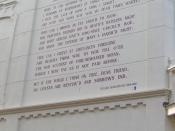In "Sonnet 116," William Shakespeare deals with imperishable love. The poet, writing in Shakespearean sonnet structure, addresses a young man of great beauty and promise. He uses various poetic techniques to relay his theme.
Through his strong belief, the author expresses his theory on love lasting forever. In the opening lines of the sonnet, Shakespeare states nothing should change "the marriage of true minds," denoting absolute accord and complete understanding between husband and wife, if their love is real. Through the technique of apostrophe, he personifies the North Star - metaphorically "an ever-fixed mark" - by saying that it "looks on tempests." By indicating the North Star "is never shaken," he compares it to love, implying that it is always there no matter what, just as true love should be. In the sestet, which immediately follows the octave, the poet uses imagery to express how time changes love: "Love's not Time's fool, though rosy lips and cheeks / Within his bending sickle compass come," and that if love is true, beauty should not faze it.
Shakespeare applies diction to better clarify his theme: "Love alters not with his brief hours and weeks, / But bears it out even until the edge of doom." He thus expresses his optimism of love lasting until the end of time. Finally to conclude the sonnet, he stresses: "If this be error and upon me proved, / I never writ, nor no man ever loved," emphasizing that if what he says is false, he never wrote nor ever loved anyone. Consequently, with his broad knowledge of love, the author convinces his readers that he strongly believes in that it is everlasting.
Thus, through his effective poetic techniques, William Shakespeare proves that true love is ultimately imperishable in this sonnet, a part of...



Comment
Quotations perhaps are a too big percentage of the whole body of the text and not much is said about the poetic techniques in fact.
2 out of 3 people found this comment useful.